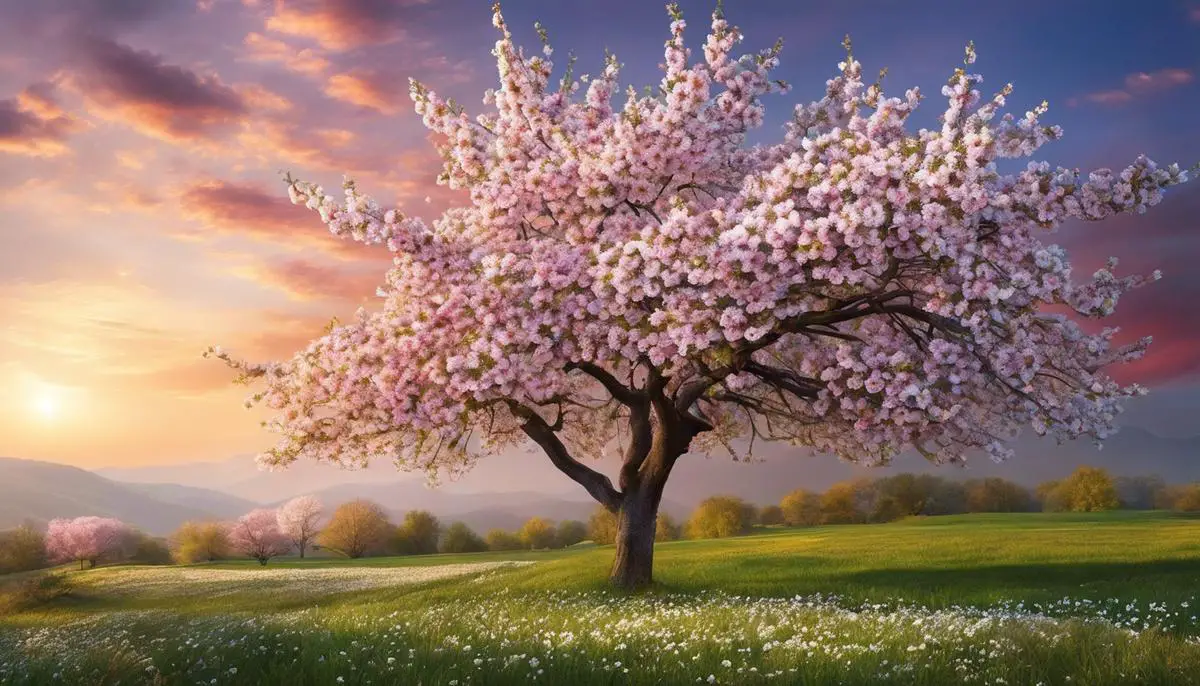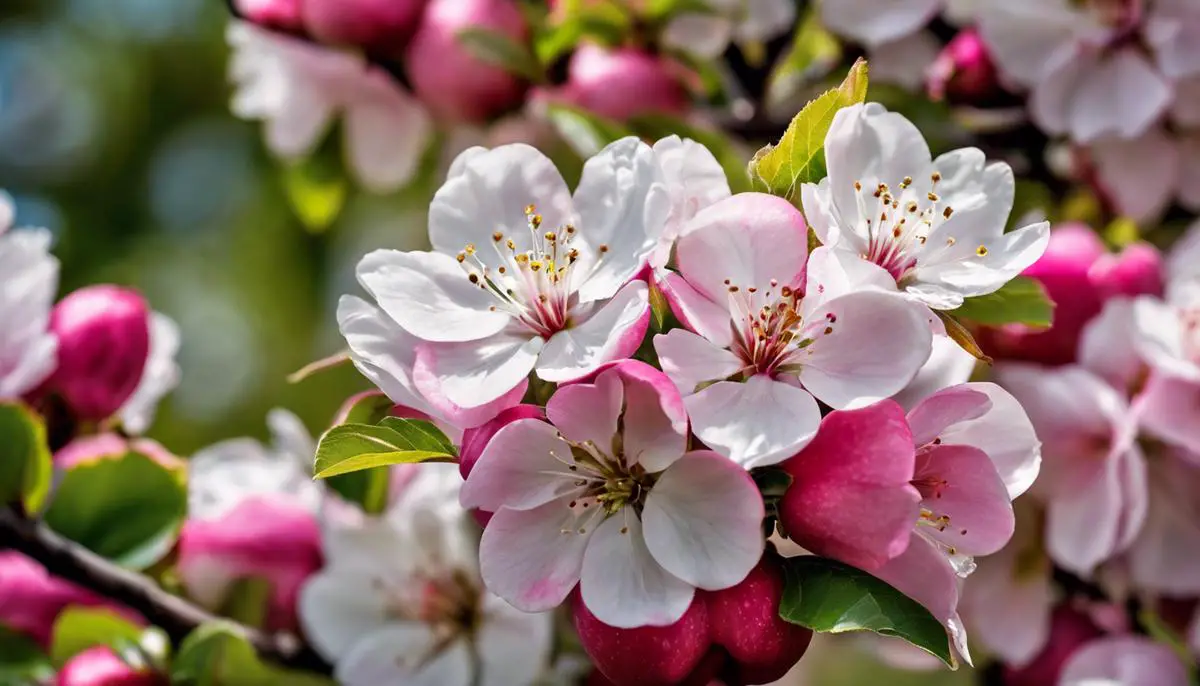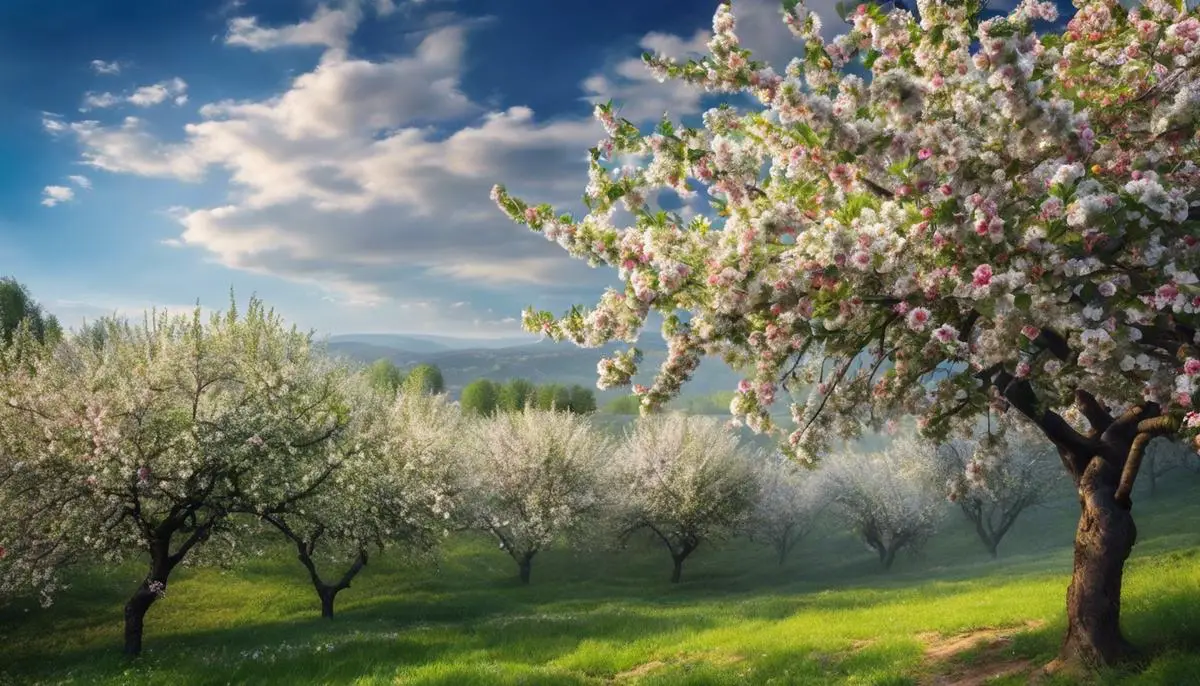The beauty of the blooming process of apple trees is a mesmerizing sequence, ushering transition from a dormant state to a glorious burst of blossoms. From bud break to full bloom, every stage of this journey not only serves a visual treat but also has a profound influence on the tree’s health and fruit-bearing potential. Bustling around these blooms, bees play a quintessential role, their busy endeavors marking the height of activity in an apple orchard. In parallel, timing and climate intricately weave into this process, with factors like temperature, rainfall, and even the distinct characteristics of apple tree varieties molding the blooming process. To fully appreciate this spectacle of nature, it’s crucial for us to understand these underlying dynamics as they unfurl.
Understanding the Blooming Process of Apple Trees
The world of apple cultivation is filled with a mix of science, nature, and a sprinkle of magic. Each year, as winter frost thaws into spring sunshine, the blooming process of apple trees paints a beautiful picture of nature’s ingenuity. Understanding this transformation not only enhances the appreciation for these deciduous wonders but also empowers hobbyists to nurture their own orchards.
Blooming is the colorful interlude between the dormancy of winter and the fruit production of summer. As soon as apple trees sense the warming temperatures and increased daylight of the spring months, they break their dormant state and kick start the blooming process. This is the tree’s response to the environmental signal that breeding season is imminent.
During this foundational phase, the apple tree begins converting stored energy into immediate fuel, which powers the new growth. Out of the bud, the first sign of flowering, emerge the leaves. This gives way to the apple tree’s darkly hued scales, signals that the tree is really awakening from its winter slumber.
As the blossoming evolves, clusters of nascent apples known as ‘fruit buds’ form along the tree’s branches. These fruit buds expand into tufted blossoms with five petals each, transforming the once barren tree into a splash of pastel pink and white hues. Visually stunning, these blossoms not only attract the eyes of apple growers but also an array of vital pollinators like bees and butterflies.
Yet, the spectacle is not merely for our enjoyment. Each blossom encloses the reproductive organs of the tree: the stamen (male part), bearing pollen, and the pistils (female parts), waiting to receive them. For successful pollination, pollen must be transported from the stamen of a blossom to the pistil of another, facilitating the fusion of male and female genetic material.
Here’s where bees and other pollinators play a pivotal role. Drawn by the color and scent of the blossom, they visit multiple flowers, inadvertently delivering pollen from stamen to pistil. This sexual reproduction process, resulting in fertilization, sets the stage for fruit development.
Following successful pollination and fertilization, the petals begin to drop, leaving behind the fertilized ovary. This ovary then starts to grow and expand, developing into what we recognize as an apple. It’s a mesmerizing sequence to witness, and is heartening to any apple cultivation hobbyist.
There you go – the blooming process of an apple tree. Beyond being simply aesthetic, it is a fascinating display of nature’s design and crucial for the fruition of those delicious apples we eagerly anticipate each year. So the next time you nibble on an apple, take a moment to marvel at its journey from flower to fruit.

Why the Timing and Climate Matter in Apple Tree Bloom
Timing and Climate: The Subtle Guides to Apple Tree Blooming
The dance between apple tree blooming and the timing and climate conditions is a ballet of Mother Nature. Mastering this understanding is pivotal for hobbyist gardeners seeking to cultivate flourishing apple trees yielding bountiful fruit.
The calendar’s shuffle plays a significant role in the blossoming paradigm. Apple trees mostly rest in a state known as vernalization during the winter – a period of low temperature that stimulates buds into bloom when favorable conditions come calling. It is during late winter and early spring, when these trees then heed the call of longer daylight hours, that the shift from dormancy to blossoming begins.
The duration of vernalization varies across apple tree varieties, with some requiring more weeks spent in dormancy compared to others. A keen gardener will need to acknowledge these inherent timings to anticipate blooming stages accurately. Missing this timing might result in less prolific fruit or unformed fruit buds which hampers the intended apple yield.
Let’s tip our hats to the climate, shall we? It holds no less importance than timing in the blossom episode of an apple tree’s life. Specific temperature ranges dictate the smooth transformation from dormancy to bloom. Apple trees need winter temperatures of around 32-45 degrees Fahrenheit for buds to break dormancy. This is then followed by a gradual rise in temperature to stimulate the budding and blooming process.
However, an extreme cold snap during the transition can result in bud damage, postponing blossoming, or even preventing it from occurring. Likewise, a sudden spell of warm weather might trigger premature blooming, which poses a risk if followed by a sudden drop in temperature. Both scenarios serve as a reminder of the apple tree’s sensitivity to weather variations and the value of consistent climate conditions.
Now, swing your attention to humidity play. It’s not as straightforward as “more water equals more fruits”. Too much humidity during the blooming period can invite fungal species that tarnish the overall health of the tree. On the other hand, too little humidity might lead trees to dehydration, impeding the bud’s development. Our apple trees appreciate a Goldilocks ‘just right’ scenario. So, keenly adjusting watering practices in response to ambient humidity levels can ensure a thriving bloom.
While mastering the orchestra of climate and timing is vital, patience, observation, and adaptive management are the gardener’s best friends in this botanical adventure. Thus, armed with awareness and appreciation of timing and climate, any apple tree enthusiast can navigate this blossoming excursion, culminating in a juicy, crispy harvest.

Caring for An Apple Tree During the Bloom
Before diving into the specific practices, it’s important to define ‘bloom care.’ This is the period from the beginning of the bud burst until the petals start to shed, which is the initiation of the fruit-set period. It’s a critical phase as the tree’s reproductive parts are exposed and decisions made (or not made) can have a significant impact on the fruit load.
Watering is crucial at this stage. More often than not, apple trees require about an inch of water per week. However, during blossom time, water should be increased to at least 1.5 inches per week. Overwatering can lead to a saturated root system and result in root diseases or reduced oxygen intake, while under watering can stress trees, potentially leading to inferior fruit.
Protection from pests and diseases during this time is also vital. Aphids, bugs and other pests can pose a threat, so Integrated Pest Management (IPM) is a must for sustaining a healthy bloom. Regular inspections help to keep track of pest populations and damage in order to decide whether control actions are necessary. If pests infiltrate, organic or synthetic pesticides could be used depending upon the severity and type of infestation.
The same rigorous accountability goes for fungal diseases. Scab, cedar apple rust, and powdery mildew are common diseases that could hit during blossom time. Choosing disease-resistant apple varieties could help prevent this. Where necessary, fungicides targeted to these issues could be applied.
Ensuring that apple trees are properly nourished is another important practice. Rigorous soil testing to check for essential nutrients like nitrogen, potassium, and phosphorous keeps trees adequately nourished during blossom time. If testing reveals a nutrient deficiency, a balanced, slow-release granular fertilizer can be applied. However, it’s important to avoid over-fertilization, which can encourage excessive vegetative growth at the cost of the blooming and fruiting process.
Pruning too plays an important role, but it should have been done during the tree’s dormant phase. Nonetheless, if any broken, dead, or diseased branches are noticed, this is the time to remove them.
Ultimately, caring involves balanced watering, guarding against pests and diseases, ensuring proper nourishment, and some light, preventive pruning. It underscores the notion that apple tree care isn’t an exact science, but a nuanced art that balances natural processes with keen observation and timely intervention.

With the backdrop of beautiful blossoms, the time when an apple tree is in bloom is not just about admiring nature’s prowess but also stepping up as caretakers. Every conscientious gardener or hobbyist plays a crucial part in nurturing these trees during this phase. Through proper feeding, watering, disease control, and making sincere efforts to attract more pollinators, we can help apple trees achieve a healthier bloom. As we observe, understand, and respond to the varying needs of these trees, we also grasp the interconnected nature of our world, making us more mindful custodians. Thus, being informed about apple tree bloom is a step towards better understanding of nature, encouraging responsible and sustainable practices.
